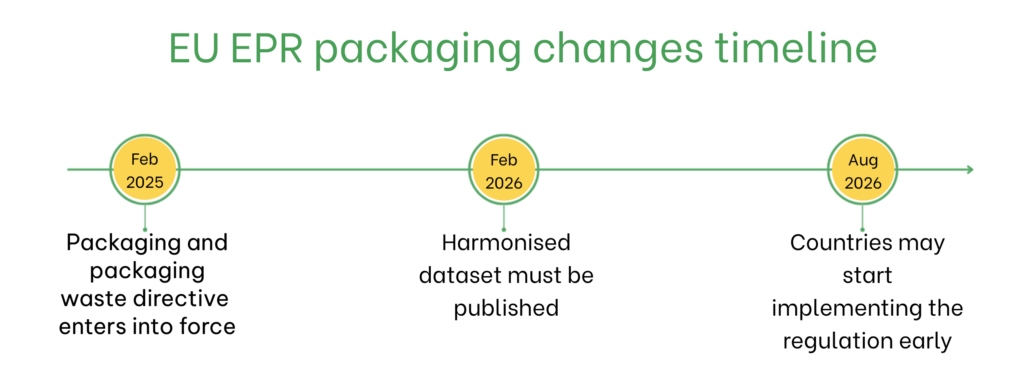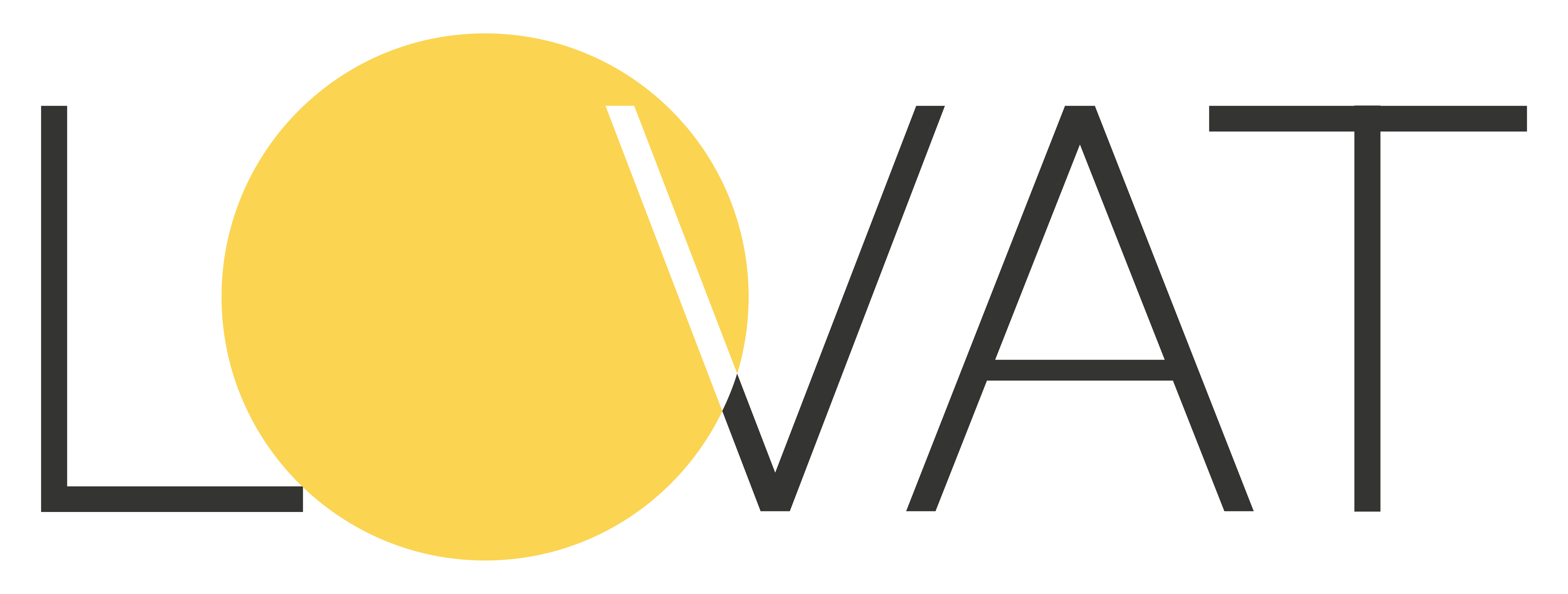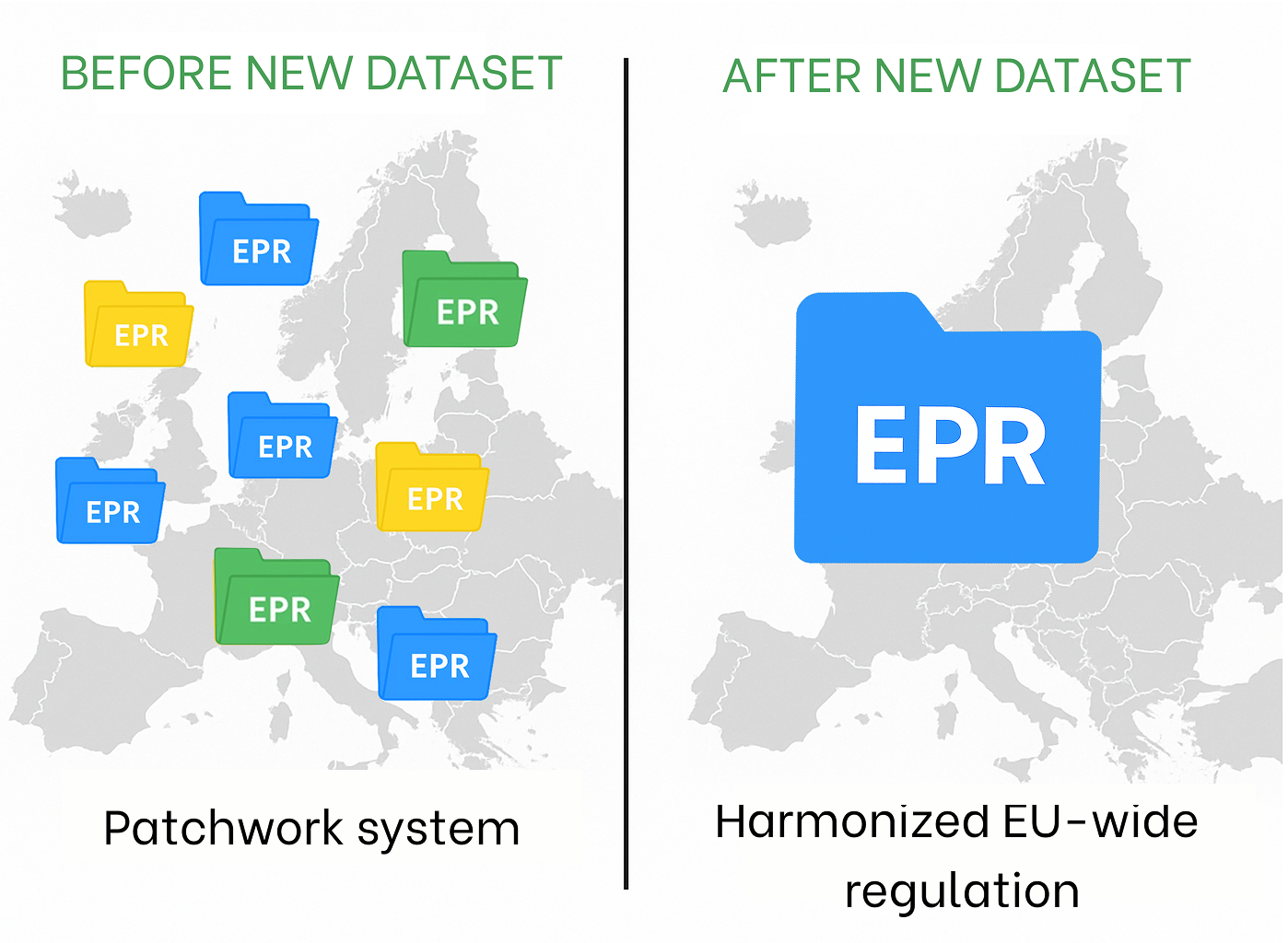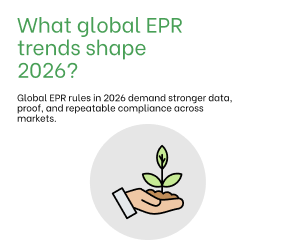5 Major EU EPR packaging changes from 2026
5 Major EU EPR packaging changes from 2026
EU EPR packaging changes from 2026 is about to change gear. The new Packaging & Packaging Waste Regulation (EU) 2025/40 (PPWR) entered into force on 11 February 2025 and will apply directly in every Member State after an 18-month transition period – from 12 August 2026.
Now we have a patchwork of rules for EPR registration by packaging. The new legislation is intended to unify the approach. Sounds good, let’s figure out what will actually change.
The most noticeable change is that the new rules establish that all remote sellers must establish (issue a written mandate) a local representative in each EU country who will register, submit reports, and pay eco tax. That is, in the registers of each country, not directly producers will be registered, as is the case now, but representatives with a mandate.
1.Fulfillment service providers under new EPR packaging changes
One of the primary EPR packaging changes from 2026 involves the role of fulfillment service providers. These businesses , including delivery firms and 3PL operators, will now be legally required to verify their clients’ compliance with EPR regulations. If a producer fails to provide accurate or complete data, services may be suspended without notice. These providers essentially become gatekeepers for compliance.
Such EPR packaging changes make it essential to keep precise packaging data readily available. Failing to do so can stop your goods from moving.
2.Marketplaces control under EPR law
Another set of EPR packaging changes from 2026 grants broader responsibilities to online marketplaces. Platforms like Amazon and eBay must now validate sellers’ EPR status before allowing them to continue selling.
Marketplaces control responsibility doesn’t stop there – they are empowered to halt transactions and freeze accounts until proof of compliance is presented. This elevates the role of the marketplace from a passive host to an active regulatory enforcer.
Businesses need to adapt to this responsibility shift, as marketplaces control responsibilities are no longer optional but legally binding across the EU
3.Harmonized dataset for reporting packaging data
Among the most significant EPR packaging changes from 2026 is the introduction of a harmonized dataset for all EU Member States. Although the final XML/JSON schema format has not been released yet, the European Commission must publish it by 12 February 2026.
This harmonisation is meant to eliminate the “patchwork” of national reporting standards that previously made compliance cumbersome. Reporting packaging data will become streamlined and comparable across borders.
By aligning reporting formats, the harmonised dataset will reduce administrative friction — but only for those who are prepared in time.
- If you need a simple way to manage EPR reporting in multiple countries, our automated platform helps you generate, submit, and track reports in full compliance
Try our EPR reporting today
4.Authorized representative requirements for a EU country
The biggest shake-up in EPR packaging changes from 2026 is the mandatory appointment of an authorized representative for all remote sellers. Companies must designate a local Authorized Representative in every country where their packaging enters the market – not just where they are headquartered.
This representative will be responsible for registration, reporting, and eco-fee payments. For example, a seller in France shipping to Germany must now appoint a German-based Authorized Representative.
Countries like Austria, Spain, and Finland already require an authorized representative, but others (e.g., Poland, Croatia, Romania) will follow suit under the new EU-wide regulation.
5.Invoice requirements for producers and marketplaces
Another critical area of EPR packaging changes from 2026 relates to invoice requirements. All producers must now quote their national producer registration number on sales documents, including invoices and marketplace listings.
This number verifies that your packaging is properly registered in each country – a safeguard against fraud and underreporting. ERP systems will need to collect SKU-level packaging weights to support accurate invoicing.
These invoice requirements mean that compliance must be embedded into everyday business operations, not treated as an afterthought.
Who is affected by EPR packaging rules from 2026
The EPR packaging changes from 2026 will impact:
- EU-based businesses shipping to customers in other EU country
- Non-EU sellers delivering directly to EU consumers
- Marketplaces, fulfillment providers, and even postal services
If your business places packaging on a market in another country, you are affected.
Key dates and timeline for EPR packaging transition
- 11 February 2025 – Packaging and packaging waste directive enters into force
- 12 February 2026 – Harmonised dataset must be published
- 12 August 2026 – Article 45 enforcement begins (Authorized Representatives appointed, EPR numbers registered)
- 2025–2026 – Countries may start implementing parts of the regulation early. Monitor national laws closely.

Key EU EPR packaging milestones: directive in Feb 2025, dataset by Feb 2026, early implementation from Aug 2026.
Current Authorized Representative for EPR packaging
Before the new Packaging and packaging waste directive becomes enforceable, the authorized representative for EPR packaging is mandatory in only a handful of EU countries. As of now, sellers without a local presence must appoint one in Austria, Spain, Finland, and Portugal. In Germany, appointing a representative remains optional, and producers can still self-register.
Country-level rules for authorized representative requirement
Here’s a snapshot of the current country-level situation regarding the authorized representative for EPR packaging:
| Country | Authorized Representative Mandatory |
| Austria | Mandatory for non-Austrian sellers |
| Spain | Mandatory for non-Spanish sellers |
| Finland | Mandatory for foreign distance sellers |
| Germany | Optional – AR appointment allowed, self-registration possible |
| Portugal | Compulsory for foreign distance sellers |
Several additional countries , such as Belgium, France, Italy, the Netherlands, Slovenia, and Sweden – already have provisions resembling these. Others like Ireland, Poland, Croatia, and Romania have yet to provide for an authorized representative for EPR packaging in their legal frameworks.
Final thoughts on how to prepare for EPR packaging changes from 2026
To stay ahead of the EPR packaging changes from 2026, take action now:
- Identify each country where you sell directly to consumers
- Appoint authorized representatives in those countries
- Update your ERP and invoicing systems to collect SKU-level packaging data
- Budget for increased eco-fees due to expanded obligations
- Train your marketplace and logistics partners on their new compliance roles
Stay informed. Subscribe to our newsletter for more updates or speak to one of our experts if you have questions.
Request a fee quote today!
Our experts help you calculate your EPR fees, handle registration, and keep you compliant with Spain’s new packaging rules 2025 – so you can focus on growing your business sustainably. Contact us




